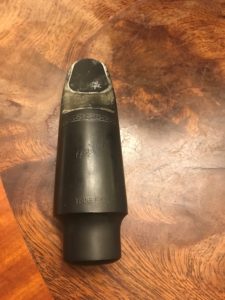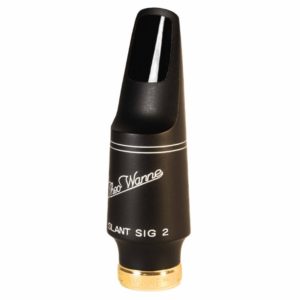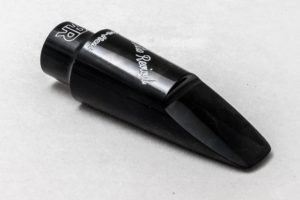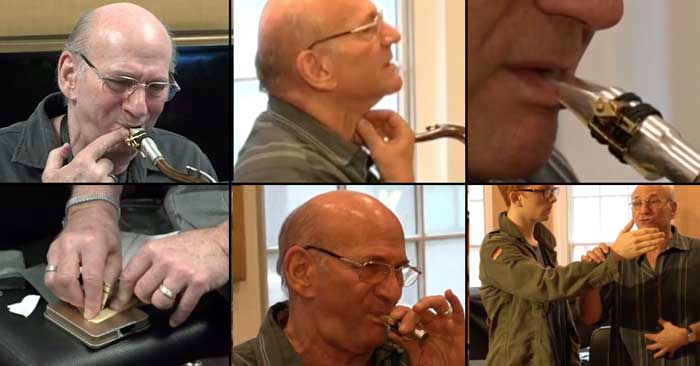Theo Wanne Slant Sig 2 Mouthpiece: How does it stack up to the competition?
Introduction
The vintage Otto Link “Slant Signature” mouthpiece is still today one of the most sought after and copied mouthpieces on the market. Almost every mouthpiece maker/manufacture offers their version of an Otto Link Slant Signature whether it be an “exact” copy or a slightly modified version. I have reviewed various Otto Link “Slant Signature” models in the past such as the Theo Wanne Slant Sig 1 (Theo Wanne Slant Sig 1 Review). With that being said, I recently received the second version of the Theo Wanne Slant Sig called the Theo Wanne Slant Sig 2.
Instead of just comparing how the Theo Wanne Slant Sig 2 stacks up against the previous version, I thought it would interesting to compare two of the best-known Slant Sig replicas (or tributes?), the Theo Wanne Slant Sig 2 and The Retro Revival Tru-Slant with my personal mouthpiece, an original Otto Link Slant Signature. I’ve included audio clips below to demonstrate the differences in sound.
Testing Equipment
- Saxophone: Lupifaro Platinum Tenor
- Reed: Woodstone 2.5 cane
- Ligature: Ishimori Sterling Silver
- Mouthpieces:
- original Otto Link Slant Signature (7)
- Theo Wanne Slant Sig 2 (7*)
- Retro Revival Tru-Slant (7)
Otto Link Slant Signature (7) (originally 6, opened to 7 by Eric Falcon)

Let’s start with a clip of the original Slant Sig to use as the “control” here, so we can get a sense of what it is that the Theo Wanne and Retro Revival pieces are striving for.
Clip
Theo Wanne Slant Sig 2 (7*)

Product Overview
Theo Wanne utilized his experience re-facing and collecting various vintage Otto Link mouthpieces to make the Theo Wanne Slant Sig 2 tenor saxophone mouthpiece. He leveraged the best design principles from the first Slant Signature models (early 1950’s) through the Early Babbitt models (1970s).
Theo believes his Slant Sig mouthpiece is the perfect mouthpiece for students and pros alike that are looking for that ‘classic’ tenor sound but do not want worry about the inconsistencies that can be found in the original vintage Otto Link mouthpieces. The Slant Sig 2 is made from premium hard rubber and features a large chamber and roll-over baffle with even side/tip rails.
After the Slant Sig 1 was released, Theo received customer feedback and made further modifications before releasing the Theo Wanne Slant Sig 2. Theo believes the Slant Sig 2 embodies even more projection, fullness and warmth to the overall sound compared to the Slant Sig 1.
Tone & Response
I found the Theo Wanne Slant Sig 2 mouthpiece was quite free-blowing with a nice core and projection to the sound. Sonically, this mouthpiece played slightly darker in the bottom end, neutral in the middle, and a bit brighter in the top end. The sound did have some edge to it when pushed, but compared to other Slant link models I have played from other manufacturers, the Theo Wanne Slant Sig 2 was cleaner and had less bite to the sound. Overall, I found from low Bb to High F# and even into the altissimo, the Slant Sig 2 maintained and even scale at various dynamic levels.
Intonation
The Theo Wanne Slant Sig 2 took very little time to adjust to and the intonation was great while working through the overtone series. I found the intonation on the Theo Wanne Slant Sig 2 slighter better than the previous model.
Build Quality
The tip and rails were even and I did not notice any scratches or unevenness with the table. I believe this mouthpiece is completely CNC’d instead of done by hand which I am quite impressed with the level of detail and what you are able to accomplish today with an advanced CNC machine. The hard rubber material responded well and the gold ring is a nice touch which I know Theo Wanne includes on all of his mouthpieces.
Overall
The Theo Wanne Slant Sig 2 in comparison to the original Theo Wanne Slant Sig 1 is significantly better in my opinion. This model projects more and is easier to play at various dynamic levels.
Clip
Find Theo Wanne Slant Sig 2 on Amazon.com
Retro Revival “Tru-Slant” (7)

Product Overview
The “Tru-Slant” is Retro-Revival’s replica of a Otto Link Tone Edge Slant Signature tenor mouthpiece (Retro Revival Mouthpiece Review). In the late 1950’s, Otto Link created the Tone Edge back in New York City and this mouthpiece quickly became the standard played by many great tenor players. The original Tone Edge was manufactured with a larger chamber and was only available up to a 6 tip opening.
After Otto Link moved to Florida, changes took place in the manufacturing process. The updated Slant Signature manufactured in Florida contained a higher rollover baffle and the tip sizes ranged from a 5 up to a 9 tip opening. This Florida version of the Otto Link Tone Edge became quite popular and is still played on by many players today.
When Otto Link decided to relocate to Elkhart Indiana with their remaining mouthpiece blanks and tooling, the Tone Edge remained excellent for quite some time, but something happened to the quality and play-ability with future production. Fortunately, Retro Revival went through the efforts play testing many versions of the Tone Edge from Bob’s & Joel’s collections to find the best one.
Clip
Final Thoughts
Whether I am playing the Theo Wanne Slant Sig 2, The Retro-Revival Tru-Slant mouthpiece or my original vintage Otto Link Slant Signature, I am going to generally sound very similar on each mouthpiece (as you can hear from the clips above).
I found the Theo Wanne Slant Sig 2 was the most free-blowing of all three mouthpieces. I believe this has to do with the Slant Sig 2’s baffle, chamber and facing curve. The Tru-Slant’s baffle to the tip and side rails is much closer to my vintage link in comparison to the Theo Wanne piece, which I would categorize as a modified Link rather than an exact replica.
The Tru-Slant feels and plays much more similarly to my vintage Link in comparison to the Slant Sig 2, but there were some differences. The Tru-Slant had the most edge and projection, but had a bit more resistance that took a little bit of time to get adjusted to.
My recommendation would be if you are looking for a free-blowing hard rubber mouthpiece with a nice core and projection that does sonically capture many characteristics of a vintage Slant Signature, the Theo Wanne Slant Sig 2 would be a mouthpiece to consider.
In comparison, if you want a Slant copy that feels and plays very similarly to an original vintage hard rubber Otto Link but from my perspective, has more edge and projection, The Retro Revival Tru-Slant would be a mouthpiece to consider as well.
Unsurprisingly, I preferred my hard rubber vintage Link. To me, it was almost a combination between the free-blowing characteristics of the Theo Wanne Slant Sig 2 but with the feel, core, and edge that I found when playing the Retro-Revival Tru-Slant.
I would like to thank Bryan Vance over at Theo Wanne for sending me the Theo Wanne Slant Sig 2 to test play and review. I would highly recommend anyone who is playing a vintage Slant Link (like me) but is looking for a back-up or replacement to add the Theo Wanne Slant Sig 2 to their list as well as other options such as the Retro Revival Tru-Slant. And who knows, those newer pieces may indeed end up replacing your original, so ultimately, it’s a matter of trying them all for yourself.
Regardless, it’s great to know that there are options when it comes to experiencing the great qualities of the legendary Otto Link Slant Signature.






November 5, 2018 @ 3:42 pm
Are there any reviews of the Otto Link Rocky Giglio tenor mouthpiece?
November 6, 2018 @ 6:31 pm
Hey Damien,
I found some further information on the RG Otto Link mouthpiece on Theo Wanne’s website. In addition from what I have read about these mouthpieces, they are much closer to a Berg Larsen than a traditional Otto Link mouthpiece. I do not know many people who play them but their are a few YouTube video’s with various people play testing them.
August 22, 2019 @ 9:31 pm
What size ishimori ligature did you use for the Theo wanne?
August 22, 2019 @ 10:04 pm
Hey Matt,
My Ishimori Lig size was the one that would fit a V16 or Standard Hard Rubber Otto Link Mouthpiece.
http://www.woodsysmusic.com/products/wood-stone-ishimori-woodwind-ligature?variant=830843486233
Has a few options
August 23, 2019 @ 11:36 am
Hello Zachary,
Thank you so much for your response. I just received my new Theo Wanne Slant 2 and really love it. I use the ishimori ligature on my clarinet and have loved it so I want to pick one up for the Slant. This review was super helpful.
August 23, 2019 @ 12:35 pm
Hello Matt,
Glad to hear! I like the sterling silver ishimori ligature but it comes all down to personal preference and what works for your setup.
December 7, 2019 @ 11:35 pm
Have you compared them to the new vintage rubber Links! I think that they play the closest to the original slant models
December 12, 2019 @ 5:48 pm
I was going to get a new Otto Link but there was so much negative response in regard to the quality I decided not to get it
December 12, 2019 @ 7:15 pm
Hey William,
I agree that the new modern links are a hit or miss in terms of overall quality but if your interested in a hard rubber or metal link, I’d recommend going to your local music store and see if they have a few for you to try. If a 6 or 7 tip opening is your preference, see if they have 2,3,4 or 5 was 7 tip opening links so you can see how they each compare. I have also play a few modern re-faced links that have been quite good.
Best,
Zach
January 31, 2020 @ 5:16 am
I’m playing this mouthpiece 7* with a 3 1/2 Alexander NY reed. I like the feel and sound of the piece very much. The piece is so freeblowing, almost too free blowing that I like your advice: step up in reed size or tipopening or suggesting trying another piece?
January 31, 2020 @ 10:53 am
Hey Josef,
I am glad you liked the Slant Sig 2. I would try either a harder strength Alexander NY or potentially a different reed cut. You could potentially try a 8 instead of a 7* but I would start with changing the reed strength and then if too hard, using a ReedGeek or sandpaper to shave down the reed.
There are many link like pieces out there but I would start with this process first and if you are interested, I can send you over some suggestions for other slant-like mouthpieces to try.